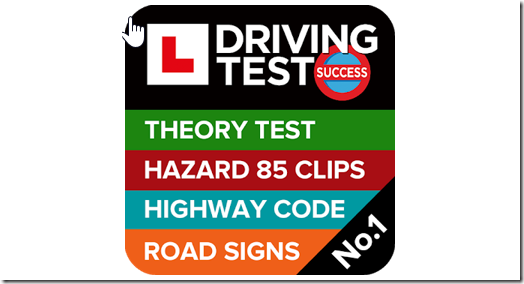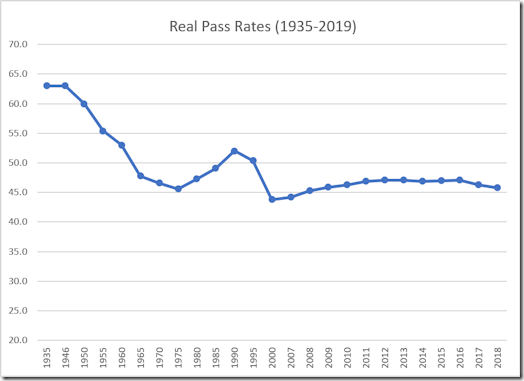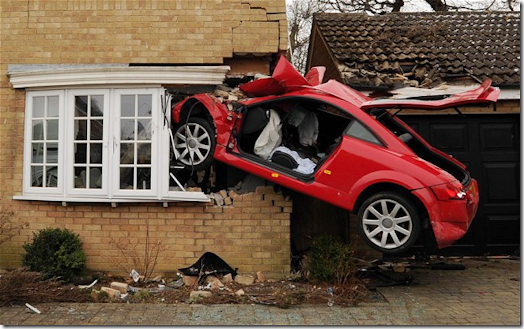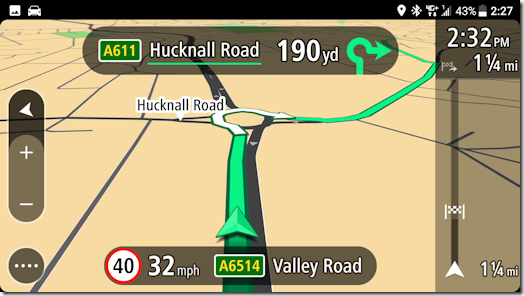All tests have been cancelled in Northern Ireland for three months. Note that this is for Northern Ireland, which is a different agency to DVSA in the rest of the UK.
Category - Driving Tests
This just came through. Driving tests are cancelled across the country for the next two days (19/20 March). Test centres are closing down. They will review the situation after that.
I’m not affected this week, but I have already warned my pupils with tests in the next month to be prepared for them not going ahead. I don’t see how they can do them with the situation developing the way it is.
It isn’t looking good.
Update 19/03/2020, 1.00pm: I have been speaking with many of my pupils who have tests in the next two weeks. I have explained to them that in my opinion there is a strong likelihood that tests are going to be cancelled for the foreseeable future. I pointed out that DVSA only sent out this communication at 9.40pm last night, and it means that ‘after that’ will fall over the weekend – so any further communication is unlikely (based on experience so far) until early next week.
One pupil decided we had better move his test back. I had booked it, and the earliest dates available are mid-June. From what I have heard elsewhere, DVSA is not allowing booking until then, so reading between the lines that is how long the test centres might be closed for. It’s three months.
I’m not saying that will happen. But at the moment it is a distinct possibility.
Update 19/03/2020 5.45pm: All tests have been cancelled in Northern Ireland for three months. Note that this is for Northern Ireland, which is a different agency to DVSA in the rest of the UK.
 This is an old article from 2013, but it is due an update. When I originally published it, one of the show-me-tell-me questions was:
This is an old article from 2013, but it is due an update. When I originally published it, one of the show-me-tell-me questions was:
Show me how you would set the demister controls to clear all the windows effectively. This should include both the front and rear screens.
At the time of updating, the relevant show & tell questions (they changed the name) are:
When it’s safe to do so, can you show me how you’d set the rear demister?
When it’s safe to do so, can you show me how you’d demist the front windscreen?
For the windscreen – that’s the one on the front of the car – the universally correct answer would be that you’d switch the airflow to blow out of the vents on the rear of the dashboard up at the windscreen, turn up the fan speed, and increase the temperature of the air from these vents. That would work for any car, although the actual knobs to twist and buttons to press will vary from model to model.
For the rear window, you’d turn on the electric heater that warms those little metal wires stuck to, or embedded in, the glass. There will be a button somewhere on the dashboard that turns it on and off.
You will note that the original broad question has now been changed to two rather more specific ones. This is relevant, because most newer cars also have air conditioning, electrically heated front windows, and often a button labelled as “MAX”, which turns everything on to demist all the windows very quickly at the same time. One press and you turn on the front and rear window electric heaters, the air conditioning, and redirect the hottest air possible at the windscreen (and often the side windows, as well, if your car has that feature).
When asked the original show-me-tell-me question, operating the MAX button was a perfectly correct response – as were playing around with the air flow controls, using the heated front windscreen if you had one, and turning on the rear window heater. However, with the much more specific Tell questions currently used, pushing the MAX button isn’t strictly the right response to either of them. It is also worth noting that whereas the original question would have been asked whilst stationary, if either of these new ones are asked, it will be while the candidate is driving. Ever since they started doing it this way, I’ve had nightmares about people fiddling with buttons and dials while taking a bend and losing control (I know the examiner would prevent that, but at the very least it would result in a test fail).
Arguably, operating the MAX button is a satisfactory response to either question, because it will achieve the desired result. But it is technically not the correct response if you’re being pedantic about it, because it does several other things at the same time.
It makes sense to understand all the controls rather than just blindly push buttons and twist knobs. If nothing else, if you inadvertently turn the car into a sauna, you ought to know how to turn the temperature back down again – and you’d be surprised by how many people can’t work out for themselves that if you turn something on by pressing a button or flicking a switch, you can usually turn it off by pressing the button again, or flicking the switch the other way. It also means that if you respond to the examiner’s question by pressing the MAX button, you’ll probably be able to recover if he specifically asks you to demist either the front or back – but not both.
How does the air-blower demist windows?
It involves a bit of science, but it is enough to know that hot air will demist windows, whereas cooler air probably won’t.
The reason it works is down to relative humidity. Air can hold water vapour as a gas, but if the amount of vapour reaches the maximum that the air can hold, it precipitates out – condenses – as water droplets. That’s the “mist” on the glass. The problem is that the maximum amount of vapour the air can hold before condensation occurs gets less and less the colder the air is. If you refer to water vapour in air as the “humidity”, then the amount of vapor relative to the maximum possible is the “relative humidity”. In summer, a relative humidity (RH) of 70% might feel horribly sticky and sweaty – but there’d be no condensation. In winter, you can easily get 100% without feeling it because there’s a lot less moisture there– but since there’s no room for any more vapour in the air, any extra causes condensation to take place. Think of it as a bucket overflowing, where the colder it is, the smaller the bucket is.
What happens is that on cold mornings, with the air at – or very closer to – 100% RH, as soon as you get in the car, breathing and perspiring, you overflow the bucket and condensation takes place. You see it on the glass as mist, but everywhere feels slightly damp. When you initially turn on the heater, it is blowing cold air, and if anything you get even more misting. But as the car warms up, it starts to blow warmer air. This warm air can hold more water vapour, and it evaporates the mist as it blows across it and keeps hold of it.
What does the air conditioning do?
Air conditioning (A/C) units pass the air over a radiator filled with coolant – just like what you have in your fridge at home. If you look back at what I said about humidity, above, you can probably work out that if you cool very moist air, you send it above 100% RH. The excess moisture – and if you cool humid air at 30°C down to 8°C, there’ll be a lot of it – condenses out (usually as a pool of water under your car in summer if you’re stopped), and much cooler and drier air is blown into the car. You can play around with the temperature of the air that is blown in by passing it over the heater radiator, so you have crude climate control.
Since it removes moisture, A/C is extremely efficient at demisting and preventing further misting.
How do the heated windows work?
In a similar way to the air blower. As they heat up they create an area around the metal wires which is warmer and so the mist evaporates back into the air. They work best in conjunction with the car heater, which heats the bulk of the air in the car, and which can then keep hold of the vapour, preventing condensation. They work even better with the A/C, because it strips the vapour out and dumps it outside the car. The MAX switch activates everything in one go.
How do you control these features?
It varies from car to car, but for the heater blower, there will be several rotary controls usually located in the centre of the dashboard and below the level of the steering wheel.

One of them controls the speed (and noise) of the fan, one controls the temperature (blue is cool, red is warmer), and another allows you to select which vents and grilles the air will be blown through (at your feet, at your face, at both, or at the windscreen – possibly with other combinations).
Higher spec cars may have digital temperature displays, and some will have independent control for each side of the car. Some will even have controls in the rear for back seat passengers.

 The heated rear window button will have an icon like the one on the left, and the heated front windscreen will have one like that shown to the right.
The heated rear window button will have an icon like the one on the left, and the heated front windscreen will have one like that shown to the right.
The air conditioning will be activated with a button or switch marked A/C, and the MAX button (which activates all of these features) may also have one of the window icons.
Isn’t the heated windscreen for de-icing?
Not specifically, no. It serves the exact same purpose as the heated rear window – to demist. However, every demisting feature in the car can also de-ice if necessary. Even blowing cold air can lead to de-icing if it isn’t too cold, because the air passing through even a cold car is still warmer than that outside. However, a heated front window is noticeably useful at de-icing since that’s the very window that needs de-icing the most.
Having said that, a heated windscreen is only good at melting frost or dislodging a thin layer of rimed ice. If you think it’s going to get rid of a couple of inches of snow, think again. It doesn’t actually get that hot – if it did, it could cause the glass to shatter.
Why do my windows steam up in summer if it’s been raining?
That’s because water cools as it evaporates. If it’s already humid when it rains, the air passing over the windscreen evaporates the rain drops, so you get cooling around them. The humid air inside the car is then above 100% RH close to these spots on the windscreen, and condensation occurs. You usually see it around spots of rain.
You can also get it if you’ve had the A/C on. It cools the windscreen right down, so when you turn the A/C off and humid air gets back in, the cold zone near the glass sends the RH there above 100% and condensation occurs. In this case, misting is more uniform, but often concentrated on the lower part of the windscreen where the A/C has been blowing.
So what should I tell the examiner on my test?
Your best bet is to answer the question he’s asking you. If he asks how you demist the back window, operate the heated rear window switch or button. If he asks how to demist the front, either demonstrate how to redirect the air flow and increase the temperature and fan speed, or operate the heated windscreen button or switch (if your car has it).
In Nottingham, examiners have not been querying use of the MAX button, so use it by all means – but just make sure you know how to activate just one of the features as necessary if your examiner presses you on the subject. You are being tested on “safe driving for life”, so you ought to know what the buttons do anyway – you’re going to need to if you pass.
Since these questions are asked while you’re driving (and since you’ll be driving when you use them once you pass), be careful not to stare down and lose control of the car.
 There was a story in the media recently about someone who attempted to cheat on the theory test by having a bluetooth device under a headscarf.
There was a story in the media recently about someone who attempted to cheat on the theory test by having a bluetooth device under a headscarf.
As usual, ADIs across the web forums and social media know more about the story than anyone else – even though they only just read it in the newspapers – and it has prompted the usual “ban the burkha” mob to mount their soapboxes once again now that Brexit has given them the necessary bravado.
The woman in question, Hatice Sadir, was Turkish. She spoke very little English, and had failed a test a few weeks previously. It appears that she paid someone £300 for a two-way bluetooth device including specially designed headscarf. She booked a test with voiceover through headphones, and this was therefore audible to whoever was on the other end of her two-way link, and they told her the answers as the questions were read out.
Test centre staff recognised her from her previous visit. They noted that she hadn’t worn a headscarf the first time and were suspicious at that, and the fact she finished the test very quickly – which they found unusual for someone with language difficulties.
You will note from the photograph of Sadir, apparently outside the court, that she appears very westernised. She has a tattoo on her arm in the fashionable mode. The fact that she is (probably) Muslim is irrelevant. However, in their versions of the story, The Sun and the Daily Mail have identified the “headscarf” as a “hijab”, as is their modus operandi these days.
Sadir, a mother of three, was just a very stupid woman who was desperate to get a licence. Her (probable) religion has nothing to do with it. The only thing I find annoying is that she got a suspended 20 month prison sentence, when she refused to identify whoever it was who was providing the service she paid for. It ought to have been 20 months in custody just for that.
 I recently saw an ADI claim that theory test apps are no good because they “only cover 5%” of the possible questions. It’s yet more complete bollocks from so-called “professionals”, and is only true – and even then, only partially – if you (or your pupil) is an idiot.
I recently saw an ADI claim that theory test apps are no good because they “only cover 5%” of the possible questions. It’s yet more complete bollocks from so-called “professionals”, and is only true – and even then, only partially – if you (or your pupil) is an idiot.
The only app I recommend to all my pupils is Driving Test Success (DTS), which is published by Focus Multimedia. I have no affiliation with Focus whatsoever – though an agent of theirs did once contact me offering such a relationship, but I never heard from him again. The full version of DTS contains all the official DVSA revision materials, and unless they are telling lies, that means exactly what it says. They also do a free “taster” version, and that only contains about a third of the total questions in the official question bank (that’s about 30%, and not 5%).
Most of my pupils buy DTS if they haven’t already got something else – some will already have the DVSA one, which is perfectly OK, and which also contains all the relevant revision material. They all pass if they use either of these.
The important word in all this is “buy”. If you wanted to get hold of the raw bank of official questions from DVSA and use it or distribute it in any way, you’d have to pay. I know, because I have looked into it myself. You can register and get the question bank for free to play around with, but the moment you start giving anyone access to it you have to pay a licence fee per unit/user to the to DVSA. If you wanted the Hazard Perception (HPT) clips, it’d cost you £800 up front just for those. You have to be approved to get the raw materials in the first place, and I asked if licensing charges would still apply if I only gave access to my own pupils. They said it would. So any official revision software would incur those same costs for the publisher.
Several years ago, I had advised a pupil to get DTS for his phone. I specifically said to get the one that cost £4.99, and not to download the free one, because it was just a trial version that didn’t have all the questions in it (at the time, it may well have contained only around 5% of the full question bank). He subsequently kept failing his theory test, and I was pulling my hair out as to why – I asked him about his school lessons, possible dyslexia and stuff, everything. He assured me there were no issues, and that he was getting 100% every time he did a mock test. After he failed for about the sixth time with a score that you could have bettered by guessing, something clicked, and I asked “how much did that app cost you?” He replied “oh, nothing. It was free”. I think my reply was something along the lines of “you prat! I told you that was a trial version”.
It turned out he’d been answering the same incomplete sample of questions over and over again (he said he wondered why he kept seeing the same ones). It was no wonder he was getting 100%. Once he bought the full version – with all the questions in it – he passed the next time.
ADIs who make stupid claims about apps only containing 5% of the questions must be of a similar mentality to that pupil. They expect free versions to be the full monty, and stupidly assume that when they aren’t then this must be true of all apps whether paid for or not. God only knows how they qualify as ADIs if they are so dumb. I figured out what “trial” meant the first time I saw it – particularly when there was the paid-for version sitting right next to it in the Android market, prompting the immediate question: why?
The only thing you need in order to pass the Theory Test is the DTS Bundle. It costs £4.99, and includes the Hazard Perception (HPT) clips. The official DVSA one is also fine and costs the same, though I haven’t used it in a long while.
There are some free ones which claim to contain all the questions, though those I’ve seen don’t have the HPT included. They contain advertising and “in-app purchases”. As I say, someone somewhere has to pay.
Frankly, for the sake of £4.99, and the risk failing the £23 Theory Test a few times because you didn’t have the right revision resources, you should stop pissing about and just buy it.

A few days ago, the media was awash with reports about how the driving test pass rate had plummeted, and it was all because of the “new parallel parking manoeuvre” that had been introduced. It was a great opportunity for ADIs who have been against “it” from the start to give their two penn’orth.
Although the link above was from The Telegraph, the Daily Mail ran the same illiterate crap, and several others followed. Comic news site, Yahoo, even went so far as to blame the same “new” manoeuvre on a separate FOI request, which revealed one candidate took 21 tests in a single year.
It seems that in the world of newspapers, someone who has just been given their first job in journalism does one of these FOIs every year. I think it must be some sort of induction test to make sure they can fill in an online form properly. And every year, without fail, there is someone somewhere who has taken an ungodly number of tests before passing (and some of them still haven’t passed, even then). It is a separate statistic which is independent of how easy or hard the test is. It merely shows that just as some people are crap journalists, there are others who are crap drivers and perhaps ought never to be allowed to drive. Ever. But it is separate.
The really laughable part is the reference to this “new parallel parking manoeuvre” – all the more laughable since there are ADIs who have allowed themselves to be associated with the claims. Because there IS no new parallel parking manoeuvre! Even some joker representing a querulous organisation which, in a previous incarnation, specialised in stirring things, ranted about how “dangerous” it is without clarifying the glaring naming error (perhaps because he didn’t know himself).
What there actually is is a piss-easy manoeuvre which involves checking your mirrors and looking ahead to make sure it’s clear, pulling over on the right-hand side of the road, then reversing back a couple of car lengths without ending up on the pavement or on the other side of the road again, and finally driving off and going back over on to the correct side safely. It’s the kind of thing any 17 year old is going to be doing 5 minutes after he passes when he sees one of his mates on the other side of the road.
The manoeuvre is referred to as “pulling up on the right”, “stopping on the right”, or similar phrases. And it is not a “parallel parking manoeuvre”.
It’s only dangerous if people haven’t been taught to do it properly. Mine have to do it on busy roads in Long Eaton and with oncoming/passing/parked lorries on a busy industrial estate in Colwick, and the only problem I’ve had was when someone decided for reasons not even known to himself to turn the wheel on to half lock as he reversed and veered outwards (and since he didn’t notice until I showed it to him on the dashcam, it was probably best he was caught early anyway). A disproportionate number of tests seem to include it, and I thought they’d pull back on it after the original introduction – where virtually every test did it – but they haven’t.
The media has claimed that the pass rate has plummeted. They base this ridiculous statement on something like the graph at the top of this article – which shows the national pass rate for the last three years. I have carefully adjusted the axes to make it look as bad as possible, just like pretty much every journalist does when they’re talking about numbers. Yet it is only a little over 1% decline over three years. If you ignore the fact that life has been going on for more than the last three years, it looks like the pass rate is on a downward slope into oblivion – even if it would take over 40 years to get to zero at the rate it is going.
However, if you look at pass rates since the introduction of the driving test in 1935, a completely different story emerges.

I cut these data down to one approximately every 5 years up until 2007, and from there on the data are yearly. Because of that, and also because I started the y-axis at 20% instead of 0%, they look a bit more dramatic than they are (i.e. the right half of the graph covers 19 years, whereas the left half covers 65 years – imagine the 1935-2000 part stretched out to three times wider).
Something odd happened between 1975 and 1990, and between 1990 and 2000 (a rise followed by a fall). But since 2000 the pass rate has been virtually flat – hovering between 44% and 47%. It is currently at about 46%, and there are no blips or drops worth a mention (i.e. any changes to the test have neither improved or worsened pass rates to any significant extent).
As I said, the top graph shows what you can do if you don’t represent data properly, and the message that comes across if you’re an ADI or journalist who doesn’t understand data is both confused and wrong.
The only time the pass rate has been significantly higher than it is now was in a different era. No internet, no smartphones, dial phones wired to the house, two postal deliveries a day (one of them before you got up), bottled milk on the doorstep, outside toilets, bin men who actually carried bins overflowing with filth and tipped them in the back of a truck, anything up to 1,000 times fewer cars on the road, no motorways, no roundabouts, and so on. DVSA does itself no favours harping on about training standards being the issue when the pass rate is hovering around 45%. It’s just the norm, and has been for almost 20 years – and up to more than 50 years if you allow a few percent extra variance.
One thing is certain. The pass rate has not fallen (or risen) significantly for the last 20 years. And the proper graph clearly shows its not likely to change much in the next 20 either – unless some idiot forces it to. I try not to say bad things about them, but I’m sure DVSA is disappointed that the 2019 data point isn’t joined by an almost vertical line up at 90%, and will likely blame this on poor training again.
Oh, I almost forgot to mention. The reason I wrote this is that DVSA has had to send out an email correcting the false media stories.
 A DVSA alert came through yesterday informing us that they’re investigating the possibility of introducing graduated driver licences (or something along those lines). Again.
A DVSA alert came through yesterday informing us that they’re investigating the possibility of introducing graduated driver licences (or something along those lines). Again.
First of all, let’s look at the facts surrounding this news (i.e. what’s actually in it, and not what the media headlines are saying).
- They’re only exploring the possibility. It won’t happen anytime soon.
- There will be a consultation before – and if – any changes are made.
- They are talking about new drivers’ “first few months on the road”.
- They don’t know exactly what – if anything – will be introduced.
- “New drivers” means everyone, and not just 17 year olds.
- Any changes would be for future new drivers.
- The impetus for this comes from the Government, and not DVSA per se.
Don’t forget that it took over 40 years to get learners able to go on the motorway, and even in my time as an ADI there were numerous “nearly” moments within different governments. Even the final kickstart took over two years to implement.
So why is the issue of graduated licences coming up once again?
Data show that 20% of new drivers have a significant accident within the first 12 months of passing their test, and it is that statistic which is being addressed. However, if we look at separate data, which has been reported many times previously, there is an enormous blip in the accident statistics where the following points are identified from individual cases of those involved:
- 17-25 year old
- male
- rural road
- on a bend
- at night
- more than one occupant in the same age group
- excessive speed involved
- no other vehicle involved
If you translate this data, it basically means young show-offs with little experience driving too fast for their skill set, distracted by their mates, and whipping the wheel round to take a bend they only saw as they entered it, then spinning off into a tree or field. Frequently, at least one passenger is fatally injured. Although males feature highly in these figures, females are still represented, where the distraction is often slightly different but equally stupid. This whole scenario is why insurance is so high for that age group.
It comes down to inexperience. Inexperience of driving, and inexperience of self-preservation. And whether you like it or not, it applies to more 17 year olds than it does 40 year olds – a) because there’s more of them, and b) 17 year olds are more likely to exhibit behaviours which compound their inexperience. The whole issue is about actual accidents and actual deaths. It’s not some random game to moan about because you think your son or daughter is an angel and shouldn’t be treated in a manner that you consider to be unfair.
I’ve mentioned this before, but many years ago I had what was then my best ever pupil. He was a smart lad, from a wealthy (-ish) family, high-achiever at school, pleasant (as was the whole family), and a quick learner. He was an excellent driver when he passed his test first time after only 23 hours of lessons. And he promised me he’d drive safely.
His mum wanted him to do Pass Plus, because she was concerned at his lack of experience – a sentiment I readily agreed with because he’d passed so quickly. Six weeks later – during which time he’d been driving in the beaten-up little Fiesta his mum had bought him – I was amazed at how far he’d drifted away from what I’d taught him. He was cornering too fast and taking chances when crossing the path of other traffic. I pulled him back during the Pass Plus and left him with some words of wisdom once it was completed.
Sometime after, I began teaching his then girlfriend, who his mum had referred to me. The girlfriend told me that he had already damaged his car by hitting a kerb cornering too fast (he hadn’t told me that), and that when he was out with his mates he would drive very fast, sometimes over 70mph in 30mph zones (he didn’t tell me that, either). I was concerned for her, but she said he’d never do it with her or with his mum in the car, because his mum would kill him if she knew. And I can promise you that he was in no way unique. Some of those I’ve taught since have made it absolutely clear how they’re going to drive when they pass. And they do.
And that’s why something has to be done. Far too many young people behave like this as a matter of course. They know full well they are in the wrong (which is why they hide it), but they do it nonetheless because it gives them street cred with the other monkeys in the jungle, and is the next best thing to sex for a 17 year old. Being inexperienced doesn’t enter the equation as far as they’re concerned. It’s no use pretending that your little darling doesn’t do it, because he or she almost certainly does to some extent. I even saw an ADI making this claim. Quite frankly, if a teenager is in rebellion mode – as many are – being the offspring of an ADI might even increase the likelihood of them behaving like prats.
So although I think DVSA isn’t addressing the root of the problem, it is at least trying to deal with the possible outcomes of that problem. Any restrictions placed on new drivers would at least give them time to gain some experience before they’re let off the leash, and the testosterone (or oestrogen) is able to kick in fully.
Not all young people are dangerous
Potentially, yes they are. They are inexperienced, and that alone is enough to lead to errors of judgment. Bad behaviour just compounds it.
When I was younger, going skiing every year was risky and fun, and resulted in a broken collar bone the first time I did it through going too fast when I was still crap. I discovered that snow-ploughing at speed (i.e. as fast as possible) over moguls on a glacier in Verbier with almost no surface snow down a black run is actually not as good an idea as I had originally thought. At the time, having the entire lift system shut down so mountain rescue could get me off the glacier and to the hospital, then being temporarily disabled and off work for a few weeks when I got back was a badge of honour. These days (and as soon as the following year, in fact), I would see it as bloody dangerous and wouldn’t be that stupid again – even though I’m a much better skier. Being unable to drive and off work now would be a royal pain in the ass, and enormously embarrassing. That’s what maturity and experience does to you.
It’s unfair to penalise only young people
They’re not. They are talking of penalising all new drivers. The fact that younger drivers would be most affected is a statistical thing, as is the fact that 20% of new drivers have a significant accident in their first year of driving.
I see older drivers driving more dangerously
That’s a separate issue. The one being addressed here is lack of experience.
My son (or daughter) doesn’t drive like that
This makes me laugh. Yes they bloody well do! Inexperience, by definition, applies to all new drivers. Furthermore, unless you are with them every time they drive, you haven’t got a clue what they get up to. I’ve lost count of the times some prat (often with “P” plates on) has pulled out in front of me or cut me up, and the only reason there hasn’t been an accident is because of my anticipation and reactions (both as a driver, and as an ADI using the dual controls). Those drivers could easily be your son or daughter. You have no knowledge of it and no control over it whatsoever. In my opinion, coming out with this statement is one of the contributing factors as to why there is a problem in the first place (along with letting them have an Audi or BMW as their first car).
Actually, that’s another thing. The only reason anyone buys an Audi (or BMW) is to drive fast, so a new driver who gets one is not going to be sticking to the speed limit or driving cautiously. The only time you’re likely to be stuck behind one being driven slowly is when the driver is texting or pissing about with the stereo. The rest of the time, they’ll be trying to get in front. You can argue as much as you want about that, but it is a simple fact. I see it every day.

This article was first published in January 2018, then updated in November of the same year. However, I noticed someone asking on a forum recently what model of TomTom was used. He was given a lot of inaccurate and misleading information.
It was announced mid-2017 – sometime before the 4 December start date – that when the DVSA introduced satnavs as part of the independent driving section, the model the examiners would be using was going to be the TomTom Start 52.
After briefly considering buying one, I decided against it. I’ve used standalone satnavs before, and the problems with mounting them and all the bloody cables has pretty much put me off for life. Even the latest ones are just too bulky to sit anywhere unobtrusively.
In the more recent past, if I’ve ever needed to navigate somewhere, I just use Google Maps in one of its forms on my smartphone. In the weeks leading up to 4 December 2017, I tried using it with pupils. It works (if you know what you’re doing), but its choice of route can be creative to say the least. And it isn’t the most chatty of navigation apps. Worse still is the inability to save pre-determined routes – and that’s essential for a driving instructor.
More recently still, I tried using the built-in satnav in my Focus on lessons. For me, it works. But the graphics are in Super Mario territory, and it also can be rather creative with its suggested routes. It can’t save pre-determined routes, and the erratic split-screen thing it does at unfathomable times is confusing to pupils. And I think the most recent map updates were drawn up by personally Christopher Columbus, because they don’t include road features installed within the last couple of years.
The more I thought about these issues as they pertain to pupils, the more I realised that the only realistic way forward was to use a TomTom in order that pupils wouldn’t be intimidated by a different looking map, different instructions, or different voices. I asked TomTom if there were any plans for an approved app that would run on Ford’s software. It seems that they did have an arrangement with Ford to develop such an app at one point, but that fell through for some reason.
Then I came across the TomTom GO app for Android. It turns your phone into a fully-blown TomTom satnav, with the added benefit of a high-res display (see the screen capture, above). TomTom GO gives you 50 miles of free navigation per month, but that gets used up in a couple of hours on lessons, so it is useless. However, you can subscribe for about £5 per month, or £15 for a full year, and get unlimited navigation (you can also subscribe separately to other TomTom services). You get unlimited world maps for this, and any updates are included. I bought the year subscription – it means I can have an absolutely up-to-date satnav all the time. A standalone one would cost ten times as much and be out of date within a year or so, as far as the base unit is concerned.
A massive additional benefit of using a TomTom (other than pupils hearing the same voice they will hear on test) is that by logging into your TomTom account on your PC or laptop you can create entire routes using a drag-and-drop map and save them. They sync automatically to all your devices through your account, and so appear in your list of saved routes. This is how DVSA has created the routes it uses. The benefit of these pre-determined routes is that you can force a specific journey around specific roundabouts or road features, rather than have the satnav try and re-route you through a shorter route to a specific destination. Of course, you can also save favourite places – like test centres or retail parks – and just set one of those as a destination and let the pupil follow whatever route the satnav comes up with. It’s all extremely flexible.
The TomTom GO app speaks through the vehicle audio system via your smartphone’s Bluetooth link (if you set it up that way).
How are pupils managing with the satnav?
At the time I started teaching it for the test, some of those I expected to have problems took to it remarkably well. A year down the line, I don’t even think about that anymore. It’s just part of what I have to teach them.
How much training does it take?
Very little, actually. The vast majority of pupils find the satnav easier to follow.
When I first started teaching it, I was planning to do it a lot. However, I now find that I bring it in nearer to their test and don’t worry about it before then. As I say, most take to it like ducks to water, so there’s no point me behaving as though ducks can’t swim.
You don’t need a TomTom
True. However, like it or not, my job is to get pupils ready for their tests, and I do that by focusing on road layout in Nottingham and not those in, say, Birmingham or Glasgow. To that end, it also makes sense to use a TomTom instead of something cheaper or just what I happen to own at the time.
It doesn’t matter what satnav pupils use
Also true – for most of them. Like I say, most take to it easily – but a few don’t. I just like to remove that variable from the equation. A significant number, for example, already have problems with roundabouts in a lesson and driving test context, so why risk them freaking out on test with unfamiliar instructions from a satnav they haven’t used before?
An example of that is the screen position and layout of the advance warning a satnav gives. If it is different on the one they are using on lessons compared to the TomTom one used on tests, they may get confused.
Like it or not, many of our pupils reach test standard by the skin of their teeth. Unlike instructors (if they were taking the test), pupils approach it from the bottom up because they are beginners. That’s why I prefer to keep directional instructions as close to those they will experience on test as possible.
You might see things differently, and that’s fine. I see it my way and teach accordingly.
I wrote this article way back in 2012. At the time, DVSA had just launched a new facility where you could find your Theory Test Certificate (TTC) number online if you’d lost the paper sheet. Here’s the link to the feature on GOV.UK.
You need the number if you’re going to book your practical test – and note that I said the number, not the certificate itself.
A lot of pupils get worried that they need to take the actual TTC to their practical test, though. By that time, many will have lost or misplaced it (quite a few of mine have, and we usually only find out the night before or on the day, which allows me to wind them up a little). Indeed, the booking confirmation you get when you book your practical says you should take your licence and TTC along with you.
In all the years I have been an instructor, I can think of only one or two occasions where the examiner has asked to see it – and those were at least ten years ago. More recently, when a pupil has offered the TTC along with their licence, the examiner isn’t interested. They only want to see the licence.
If you think about it, you wouldn’t be able to book your practical if you hadn’t passed the theory, so it’s obvious you have done when you turn up on test day.
When any of my pupils starts to fret over not being able to find their TTC – and after I’m finished winding them up – I tell them the examiner won’t ask for it, and even if he or she does, just say that you didn’t get one or that the printer at the testing station was broken when you were there. None of them have ever had to do that, though, because the examiners simply don’t ask for it.
If you still have your TTC, take it along with you by all means. But don’t worry if you’ve lost it, because unless there is some problem with your booking, I cannot see any reason why they would demand to see it.
For anyone who’s interested, I recently had a pupil who was driving on their full licence from another country inside the 12 month period they are allowed. They had a UK provisional licence, and were taking their test in their own car.
The question arose over what would happen if they failed their test. Would they be legally allowed to drive away?
I emailed DVLA, and they replied:
A non GB licence holder can still drive for up to 12 months regardless of a UK test failure.
Essentially, they could fail their test 20 times and still be allowed to drive alone on their non-UK licence inside that 12 months as long as the licence remained valid. I know that will get a lot of Brexiters hot under the collar, but it’s the way it is.
It is not voided when they obtain a provisional licence, which makes sense, since the intended purpose of that 12 month period is to give them time to pass a UK test.